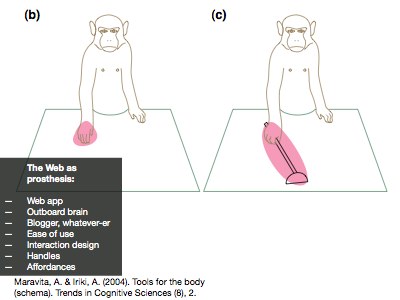Movement
Image source: Maravita, A. & Iriki, A. (2004). Tools for the body (schema). Trends in Cognitive Sciences (8), 2.
There’s another metaphor used for the Web which doesn’t reference physicality at all, and that’s prosthesis.
Or rather, by prosthesis I mean the concept of websites as tools that extend our reach or abilities.
Tools extend us. Just as I know the date of my birth because there’s a pattern of neurons in my brain that encodes it, I “know” the time because I wear a digital watch the atoms of which encode that particular memory, and I “know” what movies Ally Sheedy has been because I know how to consult IMDB.
Whether the encoding is stored outside the skull [wave] or inside it [knock knock] is neither here not there. [Read Natural Born Cyborgs by Andy Clarke for more about this concept of “extelligence”.]
The brain reflects this. After just a short amount of tool use, the same neurons that used to represent just the hand begin to represent both the hand and the entire length of the rake.
Now it took a while for us to get round to seeing the Web as a collection of tools. To my memory, the term “web app” was popularised in the year 2000.
I don’t know if anybody remembers the launch of Blogger version 2, which is when blogging all took off. You typed your post into a form, and it ran it through templates and managed your archives, and sent it back to your web host. My gosh, no HTML! It did FTP for you! There were desktop applications that did this, of course – notably Userland Software’s Frontier – but Blogger was an app that did as much as a desktop app could, but on the Web! A web app! Incredible.
This was 8 years after the launch of the Web—the technologies Blogger relied on were several years old. Just forms and FTP. There was no reason it hadn’t been done before. What was required was a change of mindset.
